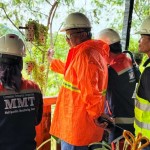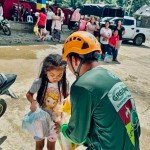-
Shores of peace and prosperity. Members of the Sta. Maria Fisherfolks Association cast-off on F/B Ruaida. After a year of fishing operations, the fishing vessel continues to generate income for the fishermen who were once members of the MNLF.
-
The road to education. Located in the heart of armed rebel territory on the island of Mindanao, Busicong used to have limited access to education. A tapping point, Zamboanga del Sur Electric Cooperative’s (Zamsureco) main line, around 200 meters going up to Imam Nasaron C. Haron Primary School, is being erected to provide electricity in the area, and now, the school buildings.
-
The Sta. Maria Fishing Village in Siocon, Zamboanga del Norte
It was the worst of times.
The decade of the 70s brought the town of Siocon in Zamboanga del Norte into a hotbed of strife when it became one of the flashpoints of Muslim rebellion in Mindanao. Then largely inhabited by Muslim Tausugs, the town played host to rebels belonging to the Moro National Liberation Front (MNLF). Its biggest component was holed up in Barangay Sta. Maria – a coastal village located in the western part of the town.
The protracted war between the state and the MNLF forces was sparked in January 1973 when government troops arrived and engaged the MNLF rebels in a firefight that lasted for three months. The battle almost reduced the town to rubble. The fiercest encounter happened in Sta. Maria where the army employed heavy artillery against the infantry of rebels who bravely held their ground. Tan Cailo, a Tausug native of the sub-village of Busicong in Sta.Maria, remembers it well.
“We had no other option but to join the MNLF. For four years, the rebels assimilated themselves into the community and stayed with us. It was a terrifying time for us. Every peace-loving resident was suspected of being a member of the MNLF. We were constantly threatened, subjected to harassment and abuses by the military even if we did not do anything wrong,” Cailo recalled.
“Soon enough, the people in the village turned out to be either combatants or sympathizers of the MNLF,” he added. The Tausugs are Muslims widely known as fearless warriors and bold seafarers.
Only fifteen years old in 1976, Cailo became a full member of the MNLF and figured in skirmishes with the army in the mountains of Sirawai and Baliguian. He started as a second liner in his unit – one who fought without a firearm and looked out for a fallen comrade so he could use his gun and continue the fight. He experienced the unbearable hardships and endless difficulties of waging a war against the government. He soon grew tired and became disillusioned when a relative died in the course of fighting.
Wanting to have an education, he quit after a year in the boondocks and settled back into the village. Although he remained a MNLF sympathizer, the young former combatant could not close his eyes to the worsening conditions suffered by his tribe as a result of the conflict. He realized that his struggle was not about gaining an independent state but achieving freedom from poverty.
After more than two decades of fighting, the MNLF forged a peace agreement with the government and disbanded, its members returning to the fold of law. Peace returned to Siocon and the tranquility that followed led to its progress. Its economy became the most vibrant in the province as there was an abundance of minerals, agricultural and fishing resources.
However, the specter of war still hovered over Sta. Maria – particularly, Busicong. The place did not even inch closer to progress. Its growth was stymied by the stigma of its violent past where it persisted in everyone’s mind as a place inhabited by belligerent warriors. As a result, government support hardly reached its people even with the most basic necessities like potable water, electricity and education.
In fairness, the Tausugs here – former MNLF soldiers – had since lived in peace, trying to forge their existence as small-time fishers of the sea.
Tan Cailo, now a first councilman of the barangay and president of the 76-member Sta.Maria Fisherfolks Association, strengthened his resolve to elevate the hardships of his people.
Meanwhile, deep in the hinterlands of Sitio Canatuan of the same town, TVI Resource Development Philippines Inc. (TVIRD), has been engaged in mining operations for years. An unwavering advocate of responsible mining, it was passionately committed to social development programs designed to help the communities affected by its operations. As TVIRD shifted its operations from gold and silver to copper and zinc mining in 2009, the wharf of Sta. Maria became the port for shipping its mining products. Once every month, the sleepy village is transformed into a shipping hub, bustling with activity as thousands of tons of copper and zinc concentrates are loaded into the ships for transport to buyers.
This was a golden opportunity for Tan Cailo. When TVIRD management offered to help his community and asked him what kind of sustainable livelihood program suited his people, he boldly ventured that they needed a “kubkoban.”
A kubkoban is a 50-foot, ring-net type, wooden-hulled fishing boat. It is powered by a diesel engine and manned by a crew of 20 to 25. It is capable of reaching as far as the Sulu Seas and carrying tons of fish. It’s true that it costs a small fortune – some Php2.8 million – but the expenses can be recouped in a short time once the boat begins to operate, Tan Cailo reasoned.
“You see, a kubkoban can earn as high as Php100 thousand pesos in just two good days of fishing. What if we go fishing twice a week, won’t we possibly be making Php800 thousand a month?” he pointed out. To show his resolve, Tan Cailo even volunteered to build the boat to save costs.
The company approved, especially given the thought of their dire circumstances. After buying the materials in Dipolog, Zamboanga City and other places, he led his men in building the boat that took them a year to finish. They named it Ruaida and it sailed for the first time on April 9, 2012.
The first time the fishnet was cast into the sea yielded an income of Php33 thousand pesos. And as of June 2013, F/B Ruaida has generated a total gross income of Php1.6 million since its first expedition. Each crew member gets an average of Php2,400 as share per voyage, which happens three to four times a month. On top of these, the Sta. Maria Fisherfolks Association Inc. enjoyed a financial windfall of Php175 thousand in savings in the bank. They said this will be used to buy a 60-ton capacity cargo truck to transport fish products to nearby towns and cities. In times of bad weather when the kubkoban could not sail, income could still be derived from the use of the truck through transport contracts – for lease or rental to others.
Actually, the Kubkoban Project is just one of the good things that happened to Sta. Maria in recent times. There has been collaboration among its people, the government, the company, well-meaning non-governmental organizations (NGOs) and private entities to finally usher the progress that has eluded it for decades. In 2010, TVIRD built a public water system. The next year, Imam Nasaron, also an ex-MNLF member, offered his land for free for the construction of an elementary school in Busicong. In early 2012, the Department of Education collaborated with TVIRD, Maple Tree Foundation (MTF), Petron Foundation, and Habitat for Humanity to establish a public elementary school that now sits proudly on a hill overlooking the serene cove and the entire Sta. Maria wharf.
This year, President Aquino moved to provide electricity to Busicong. Soon after, the Maple Tree Foundation returned to distribute computers for the school children. There is also an excellent business prospect awaiting the wives of the fishermen who have been quietly mass-producing home-made bottled sardines – with a potential market in nearby Iloilo.
Tan Cailo and the Tausugs of Sta. Maria have courageously liberated themselves from the oppression of war, no longer hearing the sound of gunfight but the bells of peace and prosperity. They are now fighting a different kind of war against the perennial enemy – poverty. With enough help, they appear to be on the threshold of celebrating victory.
Certainly, they are now anticipating the best of times.
Download PDF
Download Word Document






